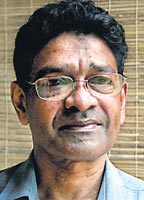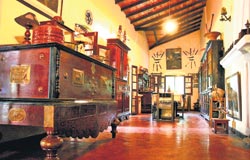
A home, a heritageOutside the sun rides high in the afternoon sky, but inside interior designer Rohan de Silva’s home in Kandy it is dark and cool. Within the Surya Kantha Maha Walauwa’s thick sturdy walls Mr. de Silva co-exists comfortably with symbols of Kandy’s glorious and ancient culture. It seems in every corner one can spot the dull gleam of old bronze, the subdued sheen of heavy, polished wood. This is obviously much more than a home – it is a treasure house. Mr. de Silva has always been passionate about Sri Lanka history. Despite having spent more than two decades in Paris, he never lost touch with the island of his birth. He has held many jobs, including that of a tour operator out of Paris, and has had an equally diverse number of interests, but only one driving passion. An avid collector of books for all his 57 years, his collection boasts more than 1,000 volumes on the subject of Sri Lanka’s vast history alone. Many of them were written when the early colonizers first came to an island that was to change forever. Pouring over these manuscripts and others, he has absorbed much about Sri Lanka’s ancient treasures, politics, society and culture.
For many years, he restricted his collection to novels alone. But in 1996, he was commissioned to decorate the interior of the Le Kandyan hotel. Intent on producing an authentic, yet unique effect he sought out numerous local craftsmen and designers. His interaction with them piqued his interest in antiques of the Kandyan era. Looking through his collection of books, he found the perfect guide: Ananda Coomaraswamy’s ‘Medieval Sinhalese Art’ and with the aid of that book he was to identify many a treasure. Talking to the craftsmen, he soon discovered that many of his new friends could trace their ancestry directly to the skilled craftsmen who created the masterpieces that adorned the homes and persons of Sri Lanka’s ancient royals and noblemen and women. Many pieces remained from this time, stored both in their houses, and in other homes around the island – unfortunately, for most part unappreciated and ignored. Even as he began to be absorbed by what he was seeing, Mr. de Silva realised that he was running short of time. For the pieces that commanded his fascination were being lost – destroyed by indifference and negligence. That was when he began collecting all he could lay his hands on, determined to preserve his heritage for posterity. Today his house is filled to overflowing with various antiques made of brass, iron, wood, and other more delicate materials. The residence itself – almost 300 years old – is a fitting space to house them in. Carefully and painstakingly renovated, it remains a lived in home, except for the fact that one would not expect to walk into the average kitchen to find it choc-a-bloc with treasures hundreds of years old. Acting as a well informed and surprisingly entertaining guide, Mr. de Silva takes us around his home.
In the entrance, extravagantly worked chunnam boxes, silver belts and wooden ola leaf book covers lie gracefully intermingled in glass display cases. The wooden rectangular covers still retain their vivid colours, against which the heavy links of the silver belts glimmer dully. Mr. de Silva explains that “the smaller chunnam boxes are for travelling - to be tucked into the fold of a sarong or attached to a belt, while the bigger ones were used at parties and formal functions where the host would place it on the table so that his guests could help themselves.” In another display case, broken bits of terracotta are propped up on stands. Squirrels and crocodiles vie for attention with demons and symbols of fertility as Mr. de Silva explains that these simple figures were buried in the ground to ensure a good harvest. Though not of the Kandyan era, these figures have his admiration for their simple artistry. “See, there they have used their fingers to form the face, you can actually see the thumbprints,” he says. He leads us on into the kitchen. Pointing out beautiful bronze plates and dishes from the Kandyan era, Mr. de Silva shows us the wonderfully intricate work that adorns each and every one of them. Other utensils, such as the ones used to make string hoppers and pittu – are placed on high shelves. In one corner a heavy grindstone and pestle lie. “See, even the pestle is artistic,” says Mr. de Silva, pointing out the sombre little head carved onto the handle of the pestle. For him, as for the creators of these artefacts, the beauty is in the details. Even simple jaggery moulds have fanciful designs carved on the inside.
This aspect – the care and thought invested in the creation of the mundane – will strike the visitor to the Maha Walauwa again and again. From the astonishingly extravagant decoration on a set of carpenters’ tools to the attention paid to a cup meant to scoop water out of a large pot, the god is in the details. “Many of these are the everyday, ordinary utensils that a villager would have used,” says Mr. de Silva adding that all the artistic motifs on various pieces are proof that their creators “loved culture more in the aesthetic form more than the utility form.” He illustrates his point by drawing our attention to drinking cups made of beautifully worked coconut shells with equally exquisitely worked buffalo horns serving as long handles. In yet another display case, hundreds of murderous looking weapons lie – except that many appear strangely distorted. Flat and squiggly, for the lack of a better word, in shape, these ‘short handled’ weapons were highly effective, reveals Mr. de Silva. “All are 17th century Kandyan arms,” he says. Pulling out a heavy cleaver, our well informed guide explains that the item was in fact an executioner’s tool. “He would have to make exactly the right cut,” he says, one which apparently had to slice through the ligaments of the jaw and the skin of the cheek rather through the neck. Why? It was more effective, and merciful. That an executioner who failed to make the correct cut would find himself the next to go onto the block, was sufficient motivation for the men to take great care. But Mr. de Silva’s favourite piece is an 18th century Kastane – carved on the handle made of horn is a lion with gleaming gold for eyes and a cutting edge that can still draw blood with ease. A romantic at heart, Mr. de Silva imagines it being owned by some noble, who once young and strong, raised it in defence both of self and country. In stark contrast to the weapons is Mr. de Silva’s other great treasure – his library. In the small connected rooms, bookshelves soar, and many impressive volumes brush the ceiling. Stored here are Mr. de Silva’s prized ola leaf books, and his many first editions. His treasures include an ancient ola leaf book within whose delicate pages all 550 Jataka stories are recounted and a first edition of Robert Knox’s 1681 “A Historical Relation of the Land of Ceylon.” And there is much more to pore over reverently in this quiet enclave. Mr. de Silva’s collection is endlessly absorbing featuring as it does not only numerous early texts but several ancient albums with photographs of a long vanished Ceylon. Taken by photographers like Scowen, these pictures were the result of many hours spent travelling from inlet to inlet with the heavy equipment loaded onto the back of bullock carts. “I have some of the oldest known photographs of Sri Lanka – taken in 1876 – in some of these albums,” reveals Mr. de Silva, adding that he has had them scanned so that they can be examined in the greatest possible detail. Momentarily arrested we lean over the Oriental Journal of 1834 which houses the stunning ‘Portrait of the Queen of Kandy.’ We are not the only ones to be granted the privilege of viewing Mr. de Silva’s breathtaking collection. He frequently has visitors from schools in the area, while students and professors have been known to come down frequently from the university. As the curator of these treasures, Mr. de Silva knows that it is both a privilege and a responsibility. Maintaining these old, sometimes delicate antiques is far from being easy. But is undoubtedly worth his time. “We have such a rich and wonderful history and culture, people should be able to see it and enjoy it,” says this custodian of the antique. |
|| Front
Page | News | Editorial | Columns | Sports | Plus | Financial
Times | International | Mirror | TV
Times | Funday
Times || |
| |
Copyright
2007 Wijeya
Newspapers Ltd.Colombo. Sri Lanka. |


